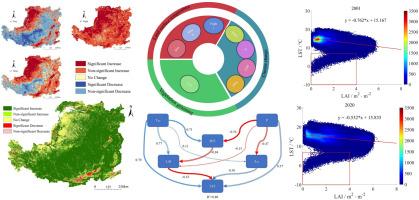Assessing the cooling effects of vegetation greening on surface temperature under climate warming in China's Loess Plateau
IF 4.1
2区 环境科学与生态学
Q1 ECOLOGY
引用次数: 0
Abstract
The Loess Plateau, a critical region for ecological restoration in China, has experienced extensive vegetation recovery since 1990s, yet its cooling effect on surface warming remains debated. Combining multi-source satellite observations (MODIS LST and GLASS LAI) with climate data, this study quantifies the spatiotemporal interplay between vegetation greening and land surface temperature (LST) dynamics across the Loess Plateau from 2001 to 2020. Results reveal a 0.038 m2·m−2·yr−1 increase in annual LAI, with 72.89 % of the region showing significant greening. Despite this, LST exhibited an overall warming trend (0.027 °C·yr−1), driven by pronounced nocturnal heating (0.064 °C·yr−1) that offset daytime cooling (−0.011 °C·yr−1). Seasonal analysis demonstrated summer cooling (−0.050 °C·yr−1) but accelerated warming in spring (0.074 °C·yr−1), autumn (0.050 °C·yr−1), and winter (0.011 °C·yr−1). Structural equation modeling identified air temperature (path coefficient: 0.79) as the dominant LST driver, while vegetation greening (LAI) exerted a significant yet spatially heterogeneous cooling effect (−0.43). During the daytime, LST is primarily influenced by air temperature (0.71) and LAI (−0.62). While, at nighttime, it is mainly governed by air temperature (0.72) and precipitation (0.48), with no significant relation to LAI (−0.08). Cooling efficiency peaked in humid eastern zones with high LAI gains but diminished in arid northwestern and urbanized areas due to energy balance alterations. Residual analysis indicates that vegetation degradation significantly accelerates surface warming (2001–2020 mean LST increase of 0.055 °C·yr−1, with 61.0 % attributed to vegetation degradation), while vegetation greening induces a pronounced diurnal asymmetry: daytime LST shows a significant cooling (−0.024 °C·yr−1, with a cooling contribution of −187.7 %), but nighttime cooling is limited (nighttime LST increase of +0.045 °C·yr−1, with only 23.2 % attributed to greening), resulting in a slight overall increase in mean LST (+0.010 °C·yr−1). These findings imply the necessity of region-specific ecological strategies to optimize vegetation climate-regulating potential under global warming.

气候变暖背景下黄土高原植被绿化对地表温度的降温效应
20世纪90年代以来,黄土高原作为中国生态恢复的重要区域,经历了广泛的植被恢复,但其对地表变暖的降温作用仍存在争议。结合多源卫星观测(MODIS LST和GLASS LAI)和气候资料,量化了2001 - 2020年黄土高原植被绿化与地表温度(LST)动态的时空相互作用。结果表明,年LAI增加了0.038 m2·m−2·yr−1,72.89%的区域绿化显著。尽管如此,地表温度呈现出整体升温趋势(0.027°C·yr - 1),这是由于夜间明显的升温(0.064°C·yr - 1)抵消了白天的降温(- 0.011°C·yr - 1)。季节分析表明,夏季变冷(- 0.050°C·yr - 1),但春季(0.074°C·yr - 1)、秋季(0.050°C·yr - 1)和冬季(0.011°C·yr - 1)加速变暖。结构方程模型表明,气温(路径系数为0.79)是主要的地表温度驱动因素,而植被绿化(LAI)具有显著的降温效应,但在空间上存在异质性(- 0.43)。在白天,地表温度主要受气温(0.71)和LAI(- 0.62)的影响。夜间主要受气温(0.72)和降水(0.48)的影响,与LAI(- 0.08)关系不显著。在LAI高的东部潮湿地区,冷却效率最高,而在西北干旱地区和城市化地区,由于能量平衡的变化,冷却效率降低。残差分析表明,植被退化显著加速了地表变暖(2001-2020年平均地表温度增加0.055°C·yr - 1,其中61.0%归因于植被退化),而植被绿化则引起了明显的日不对称性。白天地表温度呈现出显著的降温(−0.024°C·yr - 1,降温贡献为−187.7%),但夜间降温有限(夜间地表温度增加+0.045°C·yr - 1,只有23.2%归因于绿化),导致平均地表温度总体上略有增加(+0.010°C·yr - 1)。这些发现表明,在全球变暖背景下,有必要采取区域生态策略来优化植被的气候调节潜力。
本文章由计算机程序翻译,如有差异,请以英文原文为准。
求助全文
约1分钟内获得全文
求助全文
来源期刊

Ecological Engineering
环境科学-工程:环境
CiteScore
8.00
自引率
5.30%
发文量
293
审稿时长
57 days
期刊介绍:
Ecological engineering has been defined as the design of ecosystems for the mutual benefit of humans and nature. The journal is meant for ecologists who, because of their research interests or occupation, are involved in designing, monitoring, or restoring ecosystems, and can serve as a bridge between ecologists and engineers.
Specific topics covered in the journal include: habitat reconstruction; ecotechnology; synthetic ecology; bioengineering; restoration ecology; ecology conservation; ecosystem rehabilitation; stream and river restoration; reclamation ecology; non-renewable resource conservation. Descriptions of specific applications of ecological engineering are acceptable only when situated within context of adding novelty to current research and emphasizing ecosystem restoration. We do not accept purely descriptive reports on ecosystem structures (such as vegetation surveys), purely physical assessment of materials that can be used for ecological restoration, small-model studies carried out in the laboratory or greenhouse with artificial (waste)water or crop studies, or case studies on conventional wastewater treatment and eutrophication that do not offer an ecosystem restoration approach within the paper.
 求助内容:
求助内容: 应助结果提醒方式:
应助结果提醒方式:


